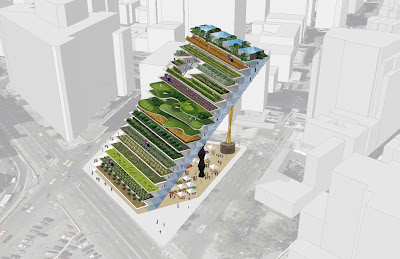This week at Forage Berkeley we are looking into small scale urban agriculture projects or home farming. We are going to highlight a few products that allow people to conduct traditional farming practices in non-traditional spaces, something we believe is a valuable part of making urban agriculture a viable method of food production in the urban environment. Individually, the amount of food being produced on home farms is small but in sufficient numbers you could develop a network of farms that permeate the urban fabric.
The folks a Window Farms, in Brooklyn NY, have developed a hydroponic vertical grow system what takes advantage of the sunniest spot in most urban houses and apartments, the window. Made of recycled products, window farms is a cheap and flexible design solution for those who don't have a yard to grow their vegetables in. Additionally, the methods creates a year round green house for those people living in northern climates.





Image from Window Farms
Britta Riley and Rebecca Bray have made all of their design ideas accessible to the public, creating a network of window farmers who regularly share their experiences and ideas on how to improve the system. As a result, the system is continuously improving and diversifying. They use Creative Commons, a non-profit organization increasing sharing and improving collaboration, to share ideas.
Although growing produce is what most people envision when they imagine urban agriculture, there is a growing movement incorporating animal husbandry into the mix. The people at Omlet, in Wardington England, have developed compact and lightweight living accommodations for you chickens, rabbits, bees and Guinea pigs.
The Eglu by Omlet
Starting at around $500, these runs are not the cheapest option for the urban dweller. However, the well designed product allows the novice farmer who wants to raise farm animals, but doesn't have allot of time, an convenient alternative. The materials (plastic and steel) also make cleaning and maintaining the product easy.

The Beehaus by Omlet

The Beehaus by Omlet
Both the Window Farm and the products developed by Omlet are providing options for ways the urban dweller might increase their self sustainability by growing and raising their own food. Also, the differences in the two project (do it yourself vs. finished product) provide a options depending on your interest and income.


























